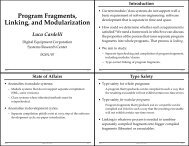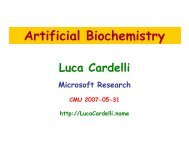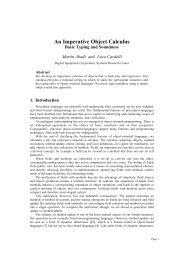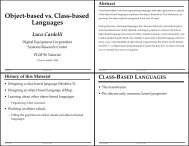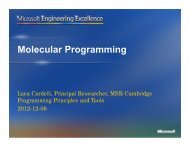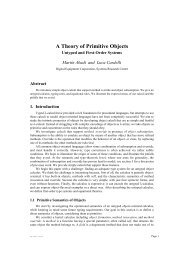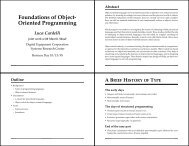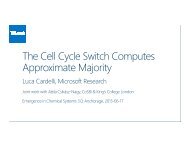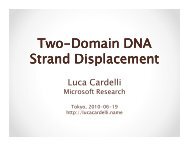Computing with Molecules - Luca Cardelli
Computing with Molecules - Luca Cardelli
Computing with Molecules - Luca Cardelli
Create successful ePaper yourself
Turn your PDF publications into a flip-book with our unique Google optimized e-Paper software.
<strong>Computing</strong> <strong>with</strong> <strong>Molecules</strong><br />
<strong>Luca</strong> <strong>Cardelli</strong><br />
Microsoft Research<br />
Development in Computational Models<br />
Cambridge 2012-06-17<br />
http://lucacardelli.name
A computational model<br />
• Molecular Soups<br />
o <strong>Molecules</strong> randomly collide and can change state or<br />
composition.<br />
• Can we compute <strong>with</strong> that?<br />
o Based on the classical atomic theory of matter<br />
• <strong>with</strong> Brownian motion<br />
• nothing quantum here<br />
• Related to:<br />
o “In small numbers” (macroscopic systems)<br />
• Process Algebra<br />
• Petri Nets<br />
o “In large numbers” (microscopic systems)<br />
• Population Protocols [Angluin et al.]<br />
• Amorphous <strong>Computing</strong> [Abelson et al.]<br />
• Swarm Intelligence – Ant Colonies<br />
• Epidemiology<br />
• Chemistry
A notion of algorithm<br />
• Data as populations<br />
o Inputs and outputs are composed of uniform<br />
populations of agents that do not have an identity<br />
o Algorithms ‘emerge’ from the ‘dumb’ interactions of<br />
‘simple’ agents<br />
• In computing<br />
o Mostly explored in discrete or nondeterministic time<br />
• In science and nature<br />
o Mostly explored in stochastic time<br />
o Stochastic because ‘interactions’ typically correspond<br />
to random collisions or chance meetings
A mathematical model<br />
• The underlying model is Continuous-Time Markov<br />
Chains<br />
o Which also underlies chemistry via the Chemical Master Equation<br />
(changes of probabilities of discrete states over continuous time).<br />
• Can be presented discretely, stochastically<br />
o As stochastic Petri nets, stochastic process algebras, etc.<br />
• NOT a probabilistic model<br />
o Probabilities emerge from the stochastic structure (as the underlying<br />
DMC), but are not primary. We are in continuous time and we care<br />
about how long things take.<br />
o Non-determinism exists only in the form of ‘quantitative races’<br />
among possibilities: who is faster is more likely to win, but there is<br />
no pure, timeless, random or probabilistic choice.<br />
o Interleaving rules: no two events (interactions) can ever happen at<br />
the same time in real time.
Basic Results<br />
• The class of functions ‘over individuals’ that are<br />
computable<br />
o Turing machines can be encoded up to an arbitrarily small<br />
uniform error bound. “Approximately Turing-Complete”.<br />
• David Soloveichik, Matt Cook, Erik Winfree, Shuki Bruck, Computation<br />
Computation<br />
<strong>with</strong> <strong>with</strong> Finite Finite Stochastic Stochastic Chemical Chemical Reaction Reaction Networks. Networks. Natural <strong>Computing</strong>,<br />
2008.<br />
• <strong>Luca</strong> <strong>Cardelli</strong>, Gianluigi Zavattaro. Turing Turing Universality Universality Universality of of the the the Biochemical<br />
Biochemical<br />
Ground Ground Form. Form. MSCS 2010.<br />
• Wiedermann et al. …<br />
• The class of predicates ‘over collectives’ that are<br />
‘stably computable’<br />
o Semi-linear predicates (first-order theory of (ℕ,+,
Paradigm<br />
• Stochastic chemistry is the simplest<br />
paradigm for this model<br />
o Finite collections of chemical reactions (<strong>with</strong> realnumber<br />
rates) among a finite set of species.<br />
o Not necessarily preserving mass or energy (assumed<br />
to be freely provided from the ‘outside’).<br />
o Usually restricted to null-, uni-, and bi-molecular<br />
reactions.<br />
• x → r y + y multiply x by 2<br />
• x + y → r y + b compute the majority of populations<br />
y + x → r x + b x and y in log time [Angluin et al.]<br />
b + x → r x + x<br />
b + y → r y + y
Molecular Languages<br />
• Reaction-Based (A + B → C + D) (Chemistry)<br />
o Limited to finite set of species (no polymerization)<br />
o Practically limited to small number of species (no run-away complexation)<br />
• Interaction-Based (A = !c. B) (Process Algebra)<br />
o Reduces combinatorial complexity of models by combining independent<br />
submodels connected by interactions.<br />
• Rule-Based (A{-}:B{p} → A{p}:B{-}) (Logic, Graph Rewriting)<br />
o Further reduces model complexity by describing molecular state, and by allowing<br />
one to ‘ignore the context’: a rule is a reaction in an unspecified<br />
(complexation/phosphorylatio) context.<br />
o Similar to informal descriptions of biochemical events (“narratives”).<br />
• Syntactic connections<br />
o The latter two can be translated (to each other and) to the first, but doing so may<br />
introduce an infinite, or anyway extremely large, number of species.
Semantic Connections<br />
Combinatorial<br />
Explosion<br />
Continuous-state Semantics<br />
(Mass Action Kinetics)<br />
Continuous<br />
Chemistry<br />
Discrete<br />
Chemistry<br />
CTMC<br />
=<br />
ODE ODE<br />
=<br />
Process<br />
Algebra<br />
CTMC<br />
Discrete-state Semantics<br />
(Chemical Master Equation)<br />
Nondeterministic<br />
Semantics<br />
Stochastic<br />
Semantics<br />
These diagrams commute via appropriate maps.<br />
L. <strong>Cardelli</strong>: “On Process Rate Semantics” (TCS)<br />
L. <strong>Cardelli</strong>: “A Process Algebra Master Equation” (QEST’07)
Paradigm Lost<br />
• But chemistry is not a computational science!<br />
o Real chemical reactions just ‘happen’ between real<br />
molecules that exist in nature. We don’t control them.<br />
o Chemists ‘transcribe’ nature and write down ‘its’ reactions.<br />
They do not write their own chemical programs.<br />
• Ok, they often design new molecules, but they do not have ‘full<br />
computational control’ over what those do.<br />
• Similarly electronics was not computational<br />
o Electron exchanges just ‘happen’ in nature.<br />
o Early physicists did not have the ability to program them.<br />
o But now we do!
Paradigm Encoded<br />
• Find some ‘universal molecules’ that can<br />
do ‘what all the other molecules can do’<br />
o By ‘doing something’ here we mean ‘implementing a<br />
chemical kinetics’.<br />
o That is: find a universal class of molecules that can<br />
emulate the kinetics of arbitrary systems of chemical<br />
reactions among real or fictitious molecules, up to<br />
some abstraction (e.g. time dilation).<br />
• Find a way to actually execute molecular<br />
languages, <strong>with</strong> real molecules.
<strong>Computing</strong> <strong>with</strong> DNA<br />
• <strong>Computing</strong> <strong>with</strong> molecules was, of course,<br />
the original idea in DNA computing<br />
o Early examples [Adelman] encoded specific<br />
algorithms.<br />
• But only recently people have proposed<br />
‘universal DNA molecules’<br />
o Soloveichik, D., Seelig, G., Winfree, E., DNA DNA as as a a<br />
a<br />
Universal Universal Universal Substrate Substrate for for Chemical Chemical kinetics.<br />
kinetics.
DNA
DNA<br />
GC Base Pair<br />
Guanine-Cytosine<br />
TA Base Pair<br />
Thymine-Adenine<br />
Sequence of Base Pairs (GACT alphabet)<br />
Interactive DNA Tutorial<br />
(http://www.biosciences.bham.ac.uk/labs/minchin/tutorials/dna.html)
• DNA in each human cell:<br />
o 3 billion base pairs<br />
o 2 meters long, 2nm thick<br />
o folded into a 6µm ball<br />
o 750 MegaBytes<br />
Robust, and Long<br />
• A huge amount for a cell<br />
o Every time a cell replicates it has to<br />
copy 2 meters of DNA reliably.<br />
o To get a feeling for the<br />
scale disparity, compute:<br />
• DNA in human body<br />
o 10 trillion cells<br />
o 133 Astronomical Units long<br />
o 7.5 OctaBytes<br />
• DNA in human population<br />
o 20 million light years long<br />
DNA wrapping into chromosomes<br />
wehi.edu.au<br />
Andromeda Galaxy<br />
2.5 million light years away
Natural DNA Operation<br />
• DNA can support structural and computational complexity.<br />
DNA replication in real time<br />
In Humans: 50 nucleotides/second<br />
Whole genome in a few hours (<strong>with</strong> parallel<br />
processing)<br />
In Bacteria: 1000 nucleotides/second<br />
(higher error rate)<br />
DNA transcription in real time<br />
RNA polymerase II:<br />
15-30 bases/second<br />
Drew Berry<br />
http://www.wehi.edu.au/wehi-tv
• Sensing<br />
Unnatural DNA Operation<br />
o Reacting to forces<br />
o Binding to molecules<br />
• Actuating<br />
o Releasing molecules<br />
o Producing forces<br />
• Constructing<br />
o Chassis<br />
o Growth<br />
• <strong>Computing</strong><br />
o Signal Processing<br />
o Decision Making<br />
Nanoscale Nanoscale Nanoscale Control Control Systems<br />
Systems<br />
Sensing<br />
<strong>Computing</strong><br />
Constructing Actuating<br />
Nucleic Acids can do all this.<br />
And interface to biology.
Sensing<br />
Aptamers: natural or artificially<br />
evolved DNA molecules that stick<br />
to other molecules (highly<br />
selectively).<br />
Target molecule<br />
Sensing<br />
<strong>Computing</strong><br />
Constructing Actuating<br />
Adenine riboswitch aptamer<br />
Structural basis for discriminative regulation of gene<br />
expression by adenine- and guanine-sensing mRNAs.<br />
Chem Biol. 2004 Dec;11(12):1729-41.
Crosslinking<br />
Constructing<br />
Chengde Mao, Purdue<br />
Sensing<br />
<strong>Computing</strong><br />
Constructing Actuating<br />
Andrew Turberfield, Oxford
DNA tweezers<br />
Bernard Yurke, Boise State<br />
Actuating<br />
DNA walkers<br />
Sensing<br />
<strong>Computing</strong><br />
Constructing Actuating
<strong>Computing</strong><br />
• Sensors and Actuators<br />
at the 'edge' of the system<br />
o They can use disparate technologies and phenomena<br />
• Computation in the 'kernel' of the system<br />
• Compositionality in the kernel<br />
o The components should use uniform inputs and outputs<br />
o The components should be ‘computationally complete’<br />
Sensing<br />
<strong>Computing</strong><br />
Constructing Actuating
• Using bacterial machinery (e.g.) as the hardware.<br />
Using embedded gene networks as the software.<br />
• MIT Registry of Standard Biological Parts<br />
• GenoCAD<br />
o Meaningful sequences [Cai et al.]<br />
• GEC<br />
“Embedded” <strong>Computing</strong><br />
o [Pedersen & Phillips]<br />
(Synthetic (Synthetic Biology) Biology)<br />
Biology)
“Autonomous” <strong>Computing</strong><br />
• Mix & go<br />
o All (or most) parts are synthesized<br />
o No manual cycling (cf. early DNA computing)<br />
o In some cases, all parts are made of DNA (no<br />
enzyme/proteins)<br />
• Self-assembled and self-powered<br />
o Can run on its own (e.g. environmental sensing)<br />
o Or be embedded into organisms, but running<br />
‘separately’<br />
(Nano (Nano-engineering)<br />
(Nano engineering)
A doctor in each cell<br />
Curing<br />
Sensing<br />
<strong>Computing</strong><br />
Constructing Actuating
RNA computation in dead cells<br />
• Using RNA Hybridization Chain Reaction<br />
for imaging of mRNA expression.<br />
o The programmability of orthogonal RNA reactions<br />
enables spatial imaging <strong>with</strong> 5 simultaneous targets.
RNA computation in live cells<br />
25
<strong>Computing</strong> <strong>with</strong><br />
DNA Strand Displacement
• Non-goals<br />
DNA <strong>Computing</strong><br />
o Not to solve NP-complete problems.<br />
o Not to replace electronics.<br />
o Not necessarily using genes or producing proteins.<br />
• For general ‘molecular programming’<br />
o To precisely control the organization and dynamics of<br />
matter and information at the molecular level.<br />
o To interact algorithmically <strong>with</strong> biological entities.<br />
o The use of DNA is “accidental”: no genes involved.<br />
o In fact, no material of biological origin.
Domains<br />
• Subsequences on a DNA strand are called domains.<br />
PROVIDED they are “independent” of each other.<br />
CTTGAGAATCGGATATTTCGGATCGCGATTAAATCAAATG<br />
x y z<br />
• I.e., differently named domains must not hybridize:<br />
o With each other<br />
o With each other’s complement<br />
o With subsequences of each other<br />
o With concatenations of other domains (or their complements)<br />
o Etc.<br />
• Choosing domains (subsequences) that are suitably<br />
independent is a tricky issue that is still somewhat of an open<br />
problem (<strong>with</strong> a vast literature). But it can work in practice.
Short Domains<br />
t<br />
t<br />
Reversible Hybridization<br />
t
Long Domains<br />
x<br />
x<br />
Irreversible Hybridization<br />
x
Strand Displacement<br />
t x<br />
t<br />
x<br />
“Toehold Mediated”
Strand Displacement<br />
t<br />
x<br />
Toehold Binding
Strand Displacement<br />
t<br />
x<br />
Branch Migration
Strand Displacement<br />
t<br />
x<br />
Displacement
Strand Displacement<br />
t<br />
x<br />
x<br />
Irreversible release
Bad Match<br />
t<br />
t<br />
x<br />
x<br />
z<br />
y
Bad Match<br />
t<br />
x<br />
z<br />
x y
Bad Match<br />
t<br />
x<br />
z<br />
x y
Bad Match<br />
t<br />
x<br />
z<br />
y<br />
Cannot proceed<br />
Hence will undo
Computation<br />
by DNA<br />
Strand Displacement
Four-Domain Architecture<br />
No “garbage collection”<br />
(active waste removal)
Three-Domain Architecture<br />
DNA <strong>Computing</strong> and Molecular Programming.<br />
15th International Conference, DNA 15,<br />
LNCS 5877, Springer 2009, pp 12-24.<br />
With garbage collection<br />
(separate pass)
“Lulu’s Trouble”<br />
(from D.Soloveichik)
DCM 2010<br />
• Looking for a simple process algebra for<br />
strand displacement<br />
o For manual or automated analysis or correctness of<br />
strand displacement ‘programs’.<br />
o Had to be simple (or you could not analyze it). Hence<br />
looking for a simpler strand displacement scheme.<br />
o Had to be an algebra, hence computation could not<br />
leave garbage around, or nothing would commute.<br />
• The technology was to be constrained by<br />
the theory
Two-Domain Architecture<br />
• Signals: 1 toehold + 1 recognition region<br />
t<br />
x<br />
• Gates: “top-nicked double strands”<br />
(or equivalently double strands <strong>with</strong> open toeholds)<br />
t x t y t<br />
In S. B. Cooper, E. Kashefi, P. Panangaden (Eds.):<br />
Developments in Computational Models (DCM 2010).<br />
EPTCS 25, 2010, pp. 33-47. May 2010.<br />
Garbage collection<br />
“built into” the gates
Input<br />
t x<br />
Transducer x→y<br />
t a<br />
y t<br />
t x t a t a x t y t a t
Input<br />
t x<br />
Transducer x→y<br />
t a<br />
y t<br />
t x t a t a x t y t a t<br />
Built by self-assembly!<br />
ta is a private signal (a different ‘a’ for each xy pair)
Transducer x→y<br />
t a<br />
y t<br />
t x t a t a x t y t a t
x t<br />
Transducer x→y<br />
t a<br />
Active<br />
waste<br />
y t<br />
t x t a t a x t y t a t
x t<br />
Transducer x→y<br />
y t<br />
t x t a t a x t y t a t
x t<br />
Transducer x→y<br />
a t<br />
y t<br />
t x t a t a x t y t a t<br />
So far, a tx tx tx signal has produced an at at cosignal.<br />
But we want signals as output, not cosignals.
x t<br />
Transducer x→y<br />
y t<br />
t x t a t<br />
a x t y t a t
x t<br />
Transducer x→y<br />
t x t a t<br />
a x t y<br />
y t<br />
t a<br />
a t
x t<br />
Transducer x→y<br />
t x t a t<br />
a x t y t<br />
t a<br />
a t
x t<br />
Transducer x→y<br />
Output<br />
t y<br />
t x t a t a x t y t<br />
Here is our output ty ty signal.<br />
t a<br />
a t<br />
But we are not done yet:<br />
1) We need to make the output irreversible.<br />
2) We need to remove the garbage.<br />
We can use (2) to achieve (1).
x t<br />
Transducer x→y<br />
Output<br />
t y<br />
t x t a t a x t<br />
y t<br />
t a<br />
a t
Transducer x→y<br />
Output<br />
t y<br />
t x t a t<br />
a x t y t<br />
t a<br />
a t
Transducer x→y<br />
x<br />
Output<br />
t y<br />
t x t a t<br />
a x t y t<br />
t a<br />
a t
Transducer x→y<br />
x<br />
Output<br />
t y<br />
t x t a t a x t y t a t
Transducer x→y<br />
a x<br />
Output<br />
t y<br />
t x t a t a x t y t a t
Transducer x→y<br />
a x<br />
Output<br />
t y<br />
t x t a t a x t y t a t<br />
Done.<br />
N.B. the gate is consumed: it is the energy source.
Transducer x→y
Join x+y→z
General n×m Join-Fork<br />
• Easily generalized to 2+ inputs (<strong>with</strong> 1+ collectors).<br />
• Easily generalized to 2+ outputs.
Two-domain gate<br />
for X+Y → Y+B<br />
X+Y�Y+B<br />
35C<br />
1x = 50nM<br />
Yuan-Jyue Chen and Georg Seelig<br />
U.Washingon.<br />
Experiments<br />
Y<br />
1x<br />
0.3x<br />
0.3x<br />
0.2x<br />
0.2x<br />
0.1x<br />
0.1x<br />
0.05x<br />
0.05x<br />
0x
An Accident of Simplicity<br />
• Earlier architectures had ‘secondary structure’,<br />
which is ‘unnatural’:<br />
o It requires synthetic single-stranded DNA that is then<br />
assembled to form the desired structures.<br />
o Synthetic DNA has maximum length and quality problems (a<br />
fixed probability of synthesis error at each position, limiting<br />
size to about 200 bases).<br />
• The two-domain architecture is (almost)<br />
ordinary biological DNA<br />
o Just double-stranded (<strong>with</strong> nicks), hence it can be produced<br />
biologically.<br />
o Biological DNA has much better quality and practically no<br />
length restriction: bacteria are so much better than we are at<br />
making it.<br />
• Makes a new manufacturing technology possible<br />
o Gate-laden plasmids (circular DNA) are inserted into<br />
bacteria, who kindly produce large quantities of them<br />
overnight.<br />
o We then chop them up into gates and introduce the nicks via<br />
enzymes.<br />
Yuan-Jyue Chen, Neil Dalchau, Cezanne<br />
Camacho, Matt Olson, David Soloveichik,<br />
Andrew Phillips, <strong>Luca</strong> <strong>Cardelli</strong>, and Georg Seelig.
DNA Programming
Strand Displacement Language
Formal Syntax and Semantics<br />
69<br />
Lakin et al. Royal Society Interface, 2011
Compiling Chemistry to DNA (X→Y)<br />
def R1x1(N,x,y) =<br />
new a<br />
( N* <br />
| N* <br />
| N* t^*:[x t^]:[a t^]:[a]<br />
| N* [x]:[t^ y]:[t^ a]:t^*<br />
)<br />
def Species(N,x) =<br />
N*<br />
Input X<br />
Output Y<br />
70
Model-Checking Compilation (X→Y)<br />
Transducer State Space (Species(1,x) | R1x1(1,x,y))<br />
71
Stochastic Model Checking<br />
PRISM results for sequential transducers<br />
72
Scaling Strand Displacement Circuits<br />
“In addition to<br />
biochemistry laboratory<br />
techniques, computer<br />
science techniques were<br />
essential.”<br />
“Computer simulations of<br />
seesaw gate circuitry<br />
optimized<br />
the design and correlated<br />
experimental data.”<br />
73
Turing-Powerful DNA Computers<br />
Encoding a Stack<br />
Encoding state transitions<br />
Model-Checking a DNA Ripple Carry Adder<br />
74<br />
Lakin & Phillips, DNA17 2011
Localised circuits<br />
Hairpins tethered to origami<br />
o Increased speed<br />
o Reduced interference<br />
75<br />
Chandran,Gopalkrishnan,Phillips,Reif. DNA <strong>Computing</strong>, 2011
Conclusions
Turing Machine, 1936<br />
Transistor, 1947<br />
Digital Computers<br />
Computer<br />
programming<br />
A Brief History of DNA<br />
DNA, -3,800,000,000<br />
Software<br />
Software<br />
systematic<br />
manipulation<br />
of information<br />
20th century<br />
systematic<br />
manipulation<br />
of matter<br />
21th Matterware<br />
Matterware??<br />
Matterware<br />
Matterware ??<br />
century<br />
Structural DNA, 1982<br />
DNA Algorithm, 1994<br />
DNA Computers<br />
Molecular<br />
programming<br />
<strong>Luca</strong> <strong>Cardelli</strong> 2012-06-18 77
Acknowledgments<br />
• Microsoft Research<br />
o Andrew Phillips<br />
• Languages and tools for DNA strand displacement.<br />
• Bologna<br />
o Pierluigi Zavattaro<br />
• Computational power of ‘chemical’ process algebras.<br />
o Cosimo Laneve<br />
• Reversibility in population models.<br />
• Aalborg<br />
o Radu Mardare<br />
• Stochastic process algebra and logic.<br />
• Caltech<br />
o Erik Winfree & Winfree Lab<br />
• DNA strand displacement as a computational method and technology.<br />
o David Soloveichik<br />
• The Programming Language of Chemical Kinetics.<br />
• U.Washington<br />
o Georg Seelig, Yuan-Jyue Chen<br />
• Manufacturing two-domain gates.



